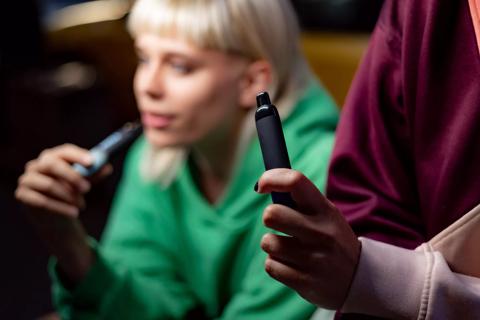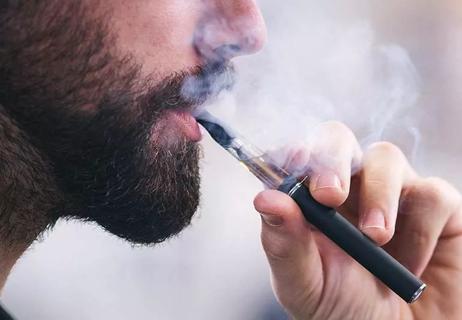Vaping isn’t a harmless alternative to smoking

E-cigarettes and vaping certainly seem like harmless alternatives to smoking. Just take a whiff, right? How bad can that poof of aerosol mist be if it smells like vanilla, strawberries or cotton candy?
Advertisement
Cleveland Clinic is a non-profit academic medical center. Advertising on our site helps support our mission. We do not endorse non-Cleveland Clinic products or services. Policy
But don’t be fooled by that faux sweetness, which has proven to be a major lure driving e-cigarette popularity with middle school and high school students.
Research links vaping to serious respiratory illnesses and other health issues. It’s an addicting and dangerous habit — and concern continues to grow as studies clarify potential consequences. (Electronic cigarettes only entered the market a little over a decade ago.)
“Not enough is known about the long-term effects of vaping,” says adolescent medicine specialist Ellen Rome, MD, MPH. “But as these illnesses come into focus, we’re learning more and starting to see that their impact mirrors traditional cigarettes.”
Let’s take a closer look with Dr. Rome, along with lung specialist Humberto Choi, MD.
E-cigarettes and vaping created enough health issues to earn an acronym: EVALI, short for e-cigarette or vaping product use-associated lung injury.
An EVALI outbreak led to more than 2,800 hospitalizations and 68 deaths across the United States, according to the U.S. Centers for Disease Control and Prevention (CDC). Case tracking took place from March 31, 2019, to February 18, 2020.
Fifteen percent of those hospitalized with EVALI during the outbreak were children. More than half of the hospitalizations for breathing issues involved people aged 24 or younger.
Advertisement
Most of the cases involved vaping products containing tetrahydrocannabinol, or THC, the major psychoactive component in marijuana. The CDC also “strongly linked” vitamin E acetate to the outbreak. (Vitamin E acetate is an additive in some THC e-cigarettes.)
Another common thread? Numerous hospitalizations involved vaping products from informal sources such as family, friends or in-person or online dealers.
Although numbers declined after the outbreak, EVALI is still a risk for e-cigarette users.
Understanding the damage vaping causes begins with knowing what happens when you use an electronic cigarette.
An e-cigarette heats liquid nicotine, chemicals and flavorings to create an aerosol for you to breathe in. Basically, the device creates a mist loaded with particles of harmful substances for you to inhale.
The substances include heavy metals such as arsenic and lead, which can be irreversibly deposited at the base of your lungs.
These particles can irritate your lungs, causing inflammation and a narrowing of the tubes where air flows in and out, explain Dr. Rome and Dr. Choi. That can lead to short-term breathing issues such as coughing and shortness of breath.
Breathing in these chemicals while vaping over a longer period of time may lead to permanent scarring and chronic conditions such as:
Nicotine is powerfully addictive — and e-cigarettes are loaded with the stimulant. In fact, some of the most popular e-cigarettes on the market have almost three times the nicotine as a pack of cigarettes, notes Dr. Rome.
The stimulant essentially rewires your brain, building an intense craving for nicotine and the feel-good dopamine rush it delivers.
Nicotine exposure also can disrupt the brain’s neurotransmitter systems, particularly among young users, says Dr. Rome. This can lead to long-term changes in cognitive development and even decreased memory ability.
In addition, nicotine levels in e-cigarettes can raise your blood pressure and put added strain on your heart. Various chemicals in e-cigarettes also have been tied to an increased risk of cancer.
Breaking a vaping habit isn’t easy either. “We know from decades of scientific research that once you begin using any nicotine-based product, it can be extremely difficult to stop,” says Dr. Choi.
Vaping isn’t a harmless alternative to smoking. It’s also not an approved method of smoking cessation by the U.S. Food and Drug Administration (FDA). (Here’s the approved list if you’re thinking of quitting.)
Advertisement
Another negative associated with vaping? It’s bad for the environment.
Discarded e-cigarettes won’t biodegrade even under severe conditions, states Dr. Rome. Plastics, nicotine salts, heavy metals (including lead and mercury) and flammable lithium-ion batteries in the devices can pollute soil and water.
That contamination is bad for wildlife and, ultimately, very bad for us.
Let’s start with the obvious: Vaping isn’t good for anyone given the health concerns already mentioned. But the CDC emphasizes that e-cigarettes should NEVER be used by:
There’s worry about the younger generation turning to vaping more regularly. Many e-cigarette products seem to target this demographic with alluring marketing campaigns and candy-like flavors.
A CDC report identified e-cigarettes as the most used tobacco product among U.S. middle school and high school students. In 2022, an estimated 2.55 million of those students used e-cigarettes — and the numbers are trending up.
Advertisement
Learn more about our editorial process.
Advertisement

Smoking can make symptoms from cancer treatment worse, and can even make treatments less effective

From dental diseases to cardiovascular problems, the harmful effects of smoking hookah have plenty of downsides for your health

Vaping exposes you to thousands of chemicals, including many that cause cancer and lung disease

Even only a couple cigarettes a day can lead to potentially deadly lung diseases like COPD and emphysema

Your risk goes down once you quit, but you may still need a lung cancer screening

Cigarettes increase your risk of developing the condition and worsening its effects

Health benefits start within 20 minutes and continue to grow for years after

Each comes with substantial health risks and should be avoided

The best parenting style balances enforcing rules and showing plenty of love

Tips include cutting back on sugar, focusing on exercise and managing stress

It can be harder to let go when you’ve invested time, energy and emotions — but it might be the healthier choice long term